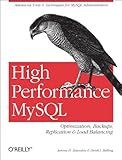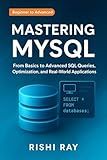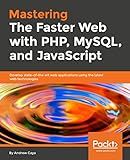Best Tools to Buy to Optimize MySQL Queries in December 2025

High Performance MySQL: Optimization, Backups, Replication, Load Balancing & More (Advanced Tools and Techniques for MySQL Administrators)



Mastering MySQL: The Complete Guide to Database Management and Optimization: From Beginner to Advanced SQL Queries, Database Design, and Performance ... From Beginner to Full-Stack Mastery Book 5)



The Microsoft SQL Server 2000 Performance Optimization and Tuning Handbook



Business Intelligence Tools for Small Companies: A Guide to Free and Low-Cost Solutions



MYSQL MASTERY FOR DATABASE ENGINEERS: 45 Practical Solutions for Tuning, Scaling & Managing High-Volume Data



Mastering The Faster Web with PHP, MySQL, and JavaScript: Develop state-of-the-art web applications using the latest web technologies


The EXPLAIN statement in MySQL is used to analyze and understand how MySQL executes a particular query. It provides information about the execution plan, including the order in which tables are accessed, the type of access (e.g., full table scan or index access), and the number of rows examined. This analysis helps optimize queries and identify potential performance bottlenecks.
To use the EXPLAIN statement, simply prefix your query with EXPLAIN. For example:
EXPLAIN SELECT * FROM users WHERE age > 30;
When you execute this statement, MySQL returns a result set with several columns. Some of the important columns in the result set are:
- id: Represents the sequence of tables accessed or joined during query execution.
- select_type: Shows the type of SELECT query being executed (e.g., simple, primary, subquery, etc.).
- table: Displays the name of the table being accessed.
- type: Indicates the type of access method used for each table (e.g., ALL, index, range, etc.). It is crucial to aim for an efficient access type to optimize query performance.
- possible_keys: Lists the potential indexes that could be used for the query.
- key: Specifies the index actually chosen for query execution.
- rows: Represents the estimated number of rows that MySQL will examine while executing the query.
- extra: Provides additional information or optimizations applied during execution, such as temporary tables, sorting, or using an index.
By analyzing the output of the EXPLAIN statement, you can understand the execution plan and identify potential issues. For example, if the query shows a table scan (type = ALL) instead of using an index, it may indicate a missing or inefficient index. Similarly, a high value in the rows column may suggest that the query is examining a large number of rows, potentially indicating room for optimization.
Overall, using the EXPLAIN statement can help you gain insights into how MySQL executes your queries, allowing you to fine-tune them for better performance.
How to analyze the "filtered" column in the EXPLAIN statement?
In an EXPLAIN statement, the "filtered" column provides information about the selectivity of the filters applied to each table during query execution. It indicates the percentage of rows that will be retrieved after applying the filters.
To analyze the "filtered" column in the EXPLAIN statement, follow these steps:
- Understand the meaning: The value in the "filtered" column represents the estimated percentage of rows that will be retrieved after applying all filters on a specific table. A lower value indicates that fewer rows will be returned, which generally suggests better performance.
- Identify problematic tables: Look for tables with a high "filtered" value, closer to 100%. This indicates that the table has fewer rows filtered out, potentially resulting in larger intermediate result sets and slower query performance.
- Correct statistics and indexes: High "filtered" values may be indicative of outdated statistics or missing indexes. Update statistics using the appropriate database commands to ensure they accurately reflect data distribution. Analyze table indexes and carefully consider adding or modifying them to optimize query performance.
- Optimize filters: Review the query and filters applied to each table. Ensure that appropriate conditions are used and that filters are properly indexed to optimize the "filtered" value. Consider rearranging filter conditions or join order, or adding additional filters to reduce the number of rows being processed.
- Compare with cardinality estimates: Compare the "filtered" value with the estimated number of rows (cardinality) in the EXPLAIN output. If the "filtered" value does not match the cardinality estimate, it may indicate a discrepancy, and further investigation might be necessary to ensure accurate query planning.
- Test and measure: Make necessary changes based on your analysis and re-run the query. Monitor query performance to see if the changes have improved the execution plan and overall query execution time.
Remember that the "filtered" value is an estimate, and while it can provide valuable insights, it should be used in conjunction with other metrics and actual performance testing to thoroughly analyze and optimize query execution.
What is the purpose of the EXPLAIN statement in MySQL?
The purpose of the EXPLAIN statement in MySQL is to provide information about how MySQL executes a query. It allows you to see the query execution plan, which includes details such as the order in which tables are accessed, the algorithms used for joins, and the indexes used. This information can be useful for optimizing queries, identifying performance issues, and understanding how the database engine processes the query.
What does the "Extra" column in the EXPLAIN statement mean?
The "Extra" column in the EXPLAIN statement provides additional information about how MySQL executes a query. It contains flags that indicate any special operations or optimizations performed by the MySQL optimizer. The values in the "Extra" column can vary depending on the type of query and the specific execution plan chosen by the optimizer. Some common values include:
- "Using index": Indicates that MySQL is utilizing an index to access the data instead of performing a full table scan.
- "Using where": Indicates that MySQL is evaluating additional conditions in the "WHERE" clause while retrieving the rows.
- "Using temporary": Indicates that MySQL is creating a temporary table to hold intermediate results during query execution.
- "Using filesort": Indicates that MySQL needs to perform a file sorting operation to satisfy an ORDER BY statement.
- "Using join buffer": Indicates that MySQL is using an in-memory buffer for joins.
The "Extra" column can provide insights into the query execution plan and identify potential performance bottlenecks.
What is the purpose of the "key_len" column in the EXPLAIN output?
The "key_len" column in the EXPLAIN output provides information about the length in bytes of the key that MySQL uses for searching and sorting when accessing the index for a particular table. The value in this column represents the maximum possible key length for the index used in the query.
The key length can vary depending on the datatypes of the columns involved in the index. For example, a key length might be longer if it involves string columns with variable lengths.
The purpose of the "key_len" column is to provide insight into how efficiently MySQL is using the index for the query. A smaller key length generally indicates better performance as it means less data needs to be processed for the index lookup. It can also help in understanding index utilization and identifying potential performance optimizations.
